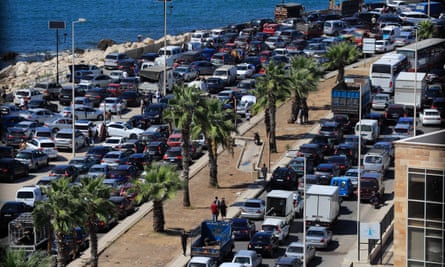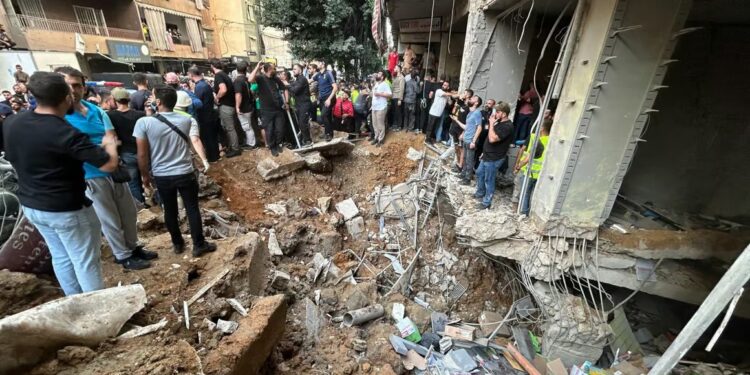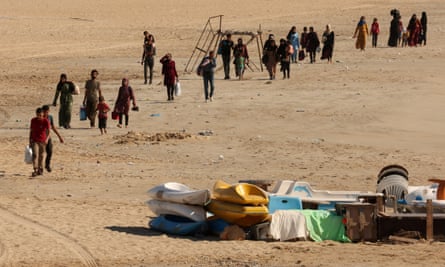Israel says it has hit 1,300 targets in escalating conflict with Hezbollah, as tens of thousands flee their homes
At least 492 people have been killed and 1,645 injured, Lebanon’s health ministry has said, after a wave of Israeli airstrikes on alleged Hezbollah targets that left the country with its highest daily death toll since the end of the 1975-90 civil war.
Tens of thousands of people fled from south Lebanese towns and villages along the main road towards the capital, Beirut, in Israel’s most intense barrage in nearly a year of cross-border clashes, as sirens were also heard in the northern Israeli city of Haifa. The Lebanese health ministry said 35 children and 58 women were among those killed.
Benjamin Netanyahu, the Israeli prime minister, said the military was changing the “security balance” along its northern border. “I promised we would change the security balance, the balance of power in the north – and that is exactly what we are doing,” the Israeli prime minister told a security meeting on Monday.
The Israel Defense Forces chief of staff, Lt Gen Herzi Halevi, said the Israeli military was preparing for the “next phases” in Lebanon, saying he would elaborate later. “Essentially, we are targeting combat infrastructure that Hezbollah has been building for the past 20 years. This is very significant,” he said.
The IDF said it had hit more than 1,300 Hezbollah targets in the previous 24 hours, in its biggest attack on the militant group since the Gaza war began last October, when Hezbollah began strikes in Israel in support of Hamas. Israel also carried out airstrikes in the Beqaa valley and its second airstrike on Beirut in a week, with what it said was a “limited” airstrike in the southern suburb of Dahieh. Israeli media reported that the target of the strike was Ali Karaki, Hezbollah’s number three military commander, although the group said he was in a safe location and unharmed by the attack.
About 35 rockets were meanwhile fired from Lebanon towards the Safed area of Israel, the Israel Defense Forces said, with some coming down in open areas close to the community of Ami’ad.https://interactive.guim.co.uk/uploader/embed/2024/09/lebanon_israel_strikes_23_sept/giv-134256bktLg1WKAxF/
The US president, Joe Biden, who on Tuesday addressed the main debate of the United Nations General Assembly in New York, said he was working to calm the situation. “I’ve been briefed on the latest developments in Israel and Lebanon. My team is in constant contact with their counterparts, and we’re working to de-escalate,” he said as he held talks with the UAE president, Sheikh Mohammed bin Zayed Al Nahyan, at the White House.
Earlier in the day, the IDF had warned Lebanese people in Beirut and other areas via a phone call to evacuate their residences and distance themselves from any buildings holding Hezbollah weapons.
“The actions will continue until we achieve our goal to return the northern [Israel] residents safely to their homes,” the Israeli defence minister, Yoav Gallant, said in a video published by his office, setting the stage for a long conflict as Hezbollah has vowed to fight on until there is a ceasefire in Gaza. “These are days in which the Israeli public will have to show composure.”
Roads leading out of south Lebanon were jammed with traffic as people fled the relentless bombing, with areas that have served as safe zones for displaced people since last year suddenly in the crosshairs of the Israeli military.
“The airstrikes have reached us, on the outskirts of [Tyre]. There was a strike just 100 metres behind the [displacement] centre, there were three of them,” said Bilal Kashmar, a coordinator in a displacement centre in the southern city. He showed a video of a plume of smoke rising just across the street from the shelter that houses hundreds of families.
“The displaced have stopped coming to us, those that want to flee are leaving the south entirely,” Kashmar said.

Tyre has hosted thousands of individuals displaced by fighting, as the city had largely been spared from airstrikes until now. Before Monday’s fighting, more than 110,000 people had been displaced from south Lebanon.
“The airstrikes aren’t stopping, airstrike on airstrike. People are scared,” said Hassan Dabouk, the head of Tyre’s Union of municipalities.
Videos of collapsed buildings and of bombs falling from the sky and the resulting explosions shaking the hands of those filming circulated on social media as people tried to track the extent of Israel’s campaign. In one video, a driver films as smoke fills the air on the road ahead of them after a strike. “Stop, stop, stop!” one of the passengers yells as the video cuts.
“An important thing to note is that the roads are not safe,” Dabouk said. “There is bombing from where we are [in Tyre] all the way to Saida. One needs to think before they leave in this situation.”
People with family and friends leaving the south made public appeals for any empty apartments or rooms that could host their loved ones. Spontaneous initiatives to provide housing emerged, with individuals marshalling calls for available rooms, and hostels offering discounted rates for displaced people.
“We are collecting numbers right now from people that have connections in safe areas, in Druze and Christian areas,” said Faten Jebai, a journalist from south Lebanon. Jebai has urged those without a place to reach out to her, as she and other volunteers work to connect displaced people with those who will open up their homes or rent at low prices.
“More than 80 members of my family are now leaving the south, so I am searching for them but also for my friends and friends of the family,” Jebai added.
The UN peacekeeping body in Lebanon (Unifil) asked its civilian staff to relocate from south Lebanon northwards, as a “precautionary measure” as fighting in south Lebanon escalated on Monday. UN peacekeepers and critical staff will remain in the south.
It issued a statement expressing “grave concern for the safety of civilians in southern Lebanon amidst the most intense Israeli bombing campaign since last October” and urging de-escalation.
“Any further escalation of this dangerous situation could have far-reaching and devastating consequences, not only for those living on both sides of the blue line, but also for the broader region,” the statement read.

Since the beginning of the war between Hamas and Israel, the Israeli military and Hezbollah have engaged in a limited conflict of attrition.
However, escalating strikes and counterstrikes have raised fears of an all-out conflict. Last week, walkie-talkies and pagers bought by Hezbollah for its members exploded, killing 42 people and wounding more than 3,000, and on Friday an Israeli strike on a Beirut suburb killed a top Hezbollah military commander and more than a dozen fighters, as well as dozens of civilians including children.
On Sunday, Hezbollah launched about 150 rockets, missiles and drones into northern Israel in retaliation for Friday’s strike.
Hezbollah has vowed to continue its strikes in solidarity with the Palestinians and Hamas, a fellow Iran-backed militant group, while Israel says it is committed to returning Israelis to the border region who were evacuated when the rocket strikes began.



Recent Comments